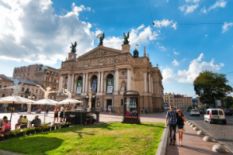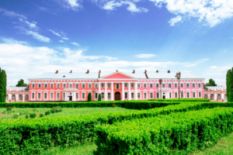Foundation of Lviv and Middle Ages

Photo: Remnants of the old Jewish cemetery in Lviv. Circa late 19th century.
Like in Odesa, the history of Jewish diaspora begins during the foundation of the city. The first written mentionings of Jewish people in Lviv are found in the oldest city register dated 1383 and 1384. The records point out a Jewish community that settled within the city fortifications. According to various historians, first Jewish settlements might have appeared in Lviv as far back as Mongol invasion in Kyiv.
The second wave of Jewish immigration took place in the 14th century. At the time, Lviv was under the reign of the Polish king Casimir III the Great, who issued a decree allowing exiled Jews from all over Europe to settle in the city. During the Middle Ages, Jews from Germany massively moved to Lviv, thus adding to its well-known diversity. Many historians find the evidence of such favorable disposition in Casimir's relationship with his Jewish mistress Esterka. Regardless of the reason, in 1367 Jews of Lviv were granted autonomy, the right for free trade and protection from persecution. Lviv became an important dot on the map of the whole Polish-Lithuanian Commonwealth.
Jewish diaspora in Lviv was unique in its structure: the only in Europe that had two separate Jewish communities, located inside the city and in the suburbs. The latter was established in 1352 in Krakow suburbs on the territory of the modern Chornovola Avenue all the way to Old Rynok Square, while the city community was founded in 1387 on Evreiska (Jewish) Street. Both communities had their own rules, privileges and separate synagogues. While the communication between them was free, marriage for people between the communities wasn’t permitted.
Thanks to numerous privileges granted by the king, the Jewish diaspora grew and accumulated wealth. At the time, Lviv was an important center of transit trade between Poland and Turkey so Jews who were engaged in trade actively influenced the economy of the city. According to various sources, domestic wholesale trade and estate rental were the most popular business occupations in the Jewish diaspora of Lviv. Besides, many Jews owned distilleries and breweries and even gave loans to Polish kings and Galician nobility. By the end of the 19th – beginning of 20th century, 70% of the world Jewish population lived on the territory of the former Polish-Lithuanian Commonwealth, including Lviv.
Jewish Architecture in Lviv
Photo: Tempel Synagogue, built in 1846. Destroyed by Nazis in 1941.
Naturally, such a large community left its trace in the city architecture and cultural heritage. According to the Jewish traditions, any settlement first has to establish a synagogue and cemetery because deceased people are to be buried the same day they died.
The first synagogues built in Lviv were wooden. Due to the extremely crowded structure of Jewish communities, though, fires weren’t uncommon — 1494, 1527, 1571 and 1616 are one of the documented fires. That’s why architects soon switched for stone: the Great City Synagogue and the private synagogue of Nakhmanovich were both built of stone. They were styled after Western European temples in Germany and the Czech Republic.
One of the oldest Jewish cemeteries in Europe was located on the territory of modern Yakov Rappaport, Kleparivska, Brovarna and Bazarna streets. Unfortunately, the 1414 historical landmark was ruined by Nazi occupants during the WWII and later finally destroyed by the Soviet authorities. In 1947, the cemetery was destructed in favor of building a product market known nowadays as Krakivskyi. Ancient tombstones were stolen and used to pave the streets.
Once Lviv was home to more than 200 synagogues and even more praying houses, but today there’s only one functioning synagogue — Tsori Gilod also known as the Beis Aharon V'Yisrael Synagogue. It is known for unique Vienna Secession style decoration typical for Art Nouveau. Some fragments of large stained glass have survived the WWII and Soviet regime.
The WWII and Nowadays
The WWII brought pogroms into Lviv right on the first day of the Nazi invasion of the Soviet Union. The morning of June 29 marked the beginning of the horrendous persecution of Jews in Lviv — they were proclaimed the ‘instigators of the war’ and killed. Those who haven’t managed to hide or escape were sent to prisons on Łącki Street, Brygidki and Zamarstyniv. Captured Jews were forced to throw away half-decomposed corpses of NKVD victims. The first days of Nazi occupation took lives of four thousand Lviv Jews.The notorious Lviv Ghetto was one of the largest ghettos established by the Nazis. By 1941, more than 80,000 Jews were forced to move to the territory of the former poor suburb Zamarstyniv to form a Jewish quarter. The Lviv Ghetto was one of the first to move people to the concentration camps — approximately 15,000 Jews were deported to the Belzec extermination camp in the span of mere several months in 1942. A year later, Nazi occupants decided to destroy the Jewish quarter and its dwellers. Many buildings were burned down, which ought to help capture the Jews who were hiding.
The period of the WWII and Nazi occupation almost completely destroyed the Jewish diaspora in Lviv. By the time the Soviet army entered the city in 1944, only 823 Jews were left alive according to the data of the Jewish Provisional Committee in Lwów. Unfortunately, the end of the war didn’t mean the end of anti-Semitism. Soviet policies allowed mass arrests and expulsion from university as a method of fighting Zionists. In 1962, the city synagogue, which was a gathering center of the community, was closed and anti-Semitic campaigns continued with the same zeal.
Photo: Memorial to the victims of Holocaust on the site of the former Lviv ghetto.
Nowadays, Jewish diaspora is engaged in reviving the cultural heritage and supporting life of the community. The Tsori Gilod synagogue on Brativ Mikhnovs'kykh Street is the religious center of the diaspora. Regardless of the Nazi and Soviet attempts to wipe off any trace of Jews from the map of Lviv, their memory is commemorated and not forgotten.
Sources: tureizahav.lviv.ua, homepage.univie.ac.at.
Photo sources: Anastasia Petrova, Bumble Dee / Shutterstock.com, infocenters.co.il, wikiwand.com, inlviv.in.ua, commons.wikimedia.org. All images belong to their rightful authors.



















